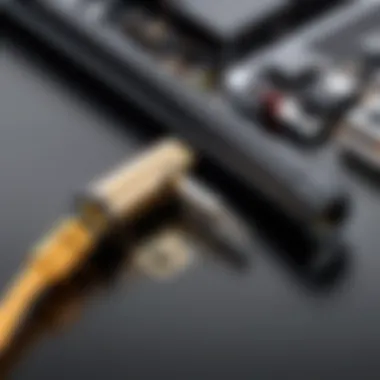Troubleshooting Laptop Sound Issues: A Comprehensive Guide


Intro
Sound issues on laptops can be frustrating, disrupting workflows and diminishing experiences with media consumption. Whether it's missing sounds from videos, unresponsive system alerts, or unclear audio during calls, these problems can stem from various sources. Understanding the root cause is crucial in resolving these audio conflicts efficiently. This guide aims to delve into hardware and software factors that contribute to sound issues, arming you with knowledge to troubleshoot effectively.
Key Features
Common Causes of Sound Problems
There are several factors that could lead to sound problems on laptops. Identifying these is the first step toward resolution:
- Hardware Issues: Problems may arise from internal components like speakers or sound cards. Physical damage can lead to poor sound quality or loss of sound altogether.
- Software Settings: Sometimes, the issue might be as simple as the audio settings being incorrectly configured or muted.
- Driver Problems: Outdated or corrupted audio drivers can inhibit sound output. Keeping these updated is essential for optimal performance.
Understanding these key causes helps users narrow down possible solutions effectively.
Product Specifications
Technical Specifications
Laptops generally come with sound cards or integrated audio systems. The specifications vary by model and brand. Here are some common specifications to consider:
- Audio Type: Stereo or surround sound capability.
- Speakers: Quality and output level of internal speakers.
- Connectivity: Availability of Bluetooth or audio jack for external devices.
Compatibility and Connectivity
When troubleshooting sound issues, it's important to check compatibility with external devices. Issues may stem from:
- Bluetooth Connections: Sometimes, connectivity issues arise when non-compatible devices connect.
- Wired Headphones: Inconsistent performance with various headphone brands.
- Port Functionality: Testing different ports can reveal if there’s an issue specific to one connection.
"Understanding your laptop’s specifications provides insight into troubleshooting sound issues effectively."
Understanding Laptop Sound Systems
In order to address any sound issues on your laptop, it is essential to comprehend the underlying sound system. A laptop's sound capabilities depend on multiple factors including both hardware and software. Understanding these elements can help one efficiently identify and resolve problems when they arise.
The Role of Drivers
Drivers are critical software components that facilitate communication between the operating system and hardware devices, including sound cards. Without the proper drivers installed, your laptop may fail to recognize or effectively utilize its sound hardware, leading to various audio-related issues. An updated or compatible driver ensures optimal performance, enabling features like surround sound or advanced audio settings.
Installed drivers often come as part of the laptop's original software package, but updates may need to be sourced from the manufacturer’s website. Regularly checking for driver updates can significantly improve sound quality and fix bugs that potentially disrupt audio playback.
Hardware Components Involved in Sound
The physical components that generate sound in laptops include the sound card, speakers, and sometimes external connections. The sound card converts digital audio signals into analog signals, which are then output through the speakers or headphones. High-quality sound cards can enhance audio fidelity, making them crucial for audiophiles or those using their laptops for media production.
In addition to the sound card, the quality and configuration of built-in speakers play an important role. Poorly designed speakers may output distorted sound or insufficient volume. Therefore, external devices like quality headphones or speakers can offer a more satisfying audio experience.
The combination of these components determines the overall sound performance of the laptop, making it imperative to understand both hardware and software aspects when troubleshooting sound issues.
Identifying Common Sound Problems
Identifying common sound problems is a critical part of troubleshooting laptop audio issues. Sound not functioning properly can significantly impact productivity and enjoyment of multimedia content. Recognizing these problems early on can save time and prevent further complications. Users can better understand the source of their issues and respond accordingly if they know what typical problems exist. Addressing sound issues often requires careful analysis of evidence presented by the laptop's behavior. This can lead to effective resolutions and a more satisfying user experience.
No Sound Output
Experiencing no sound output can be frustrating. This condition can result from several factors, including muted settings, broken speakers, or software issues. It's crucial to check the basics first. Ensure that the volume is turned up, the laptop is not muted, and external devices are properly connected.
If those options do not remidiatly work, users should look into the audio settings on the system. For instance, access the sound control panel and verify that the correct playback device is selected. Sometimes, external devices like Bluetooth speakers can take priority when connected, causing internal speakers to cease functioning.
In some cases, a complete restart of the laptop can clear temporary glitches that may cause no audio output.
Distorted or Low Sound Quality
Issues with distorted or low sound quality often frustrate users who rely on clear audio for tasks. This type of problem can stem from various sources, including faulty drivers or poor audio settings. It’s important to evaluate the state of audio drivers first. Outdated drivers can significantly reduce audio performance.
Another aspect to investigate is the equalizer or sound enhancement settings within the audio configuration. Sometimes, sound enhancements can undesirably affect audio quality.


Users should also check hardware aspects, such as the speakers. If using external speakers, ensure that they are properly powered and connected. If they are connected and functioning, perform a test by plugging in headphones to determine if the problem continues.
Sound Only in Headphones
When sound only plays through headphones, the issue can be indicative of a misconfiguration in audio settings or a hardware malfunction. First, checking the audio output configuration is advised. Navigate to the sound settings panel and ensure the internal speaker option is enabled. Sometimes, when headphones are plugged into the audio jack, the system defaults to that output.
Next, inspect the audio jack. Dust or debris accumulation can affect connectivity and hinder sound from reaching the internal speakers.
If the settings appear correct and the hardware is clean, users should consider testing with different headphones. This may reveal whether the issue lies with the headphones or the laptop itself.
"Identifying sound issues can lead to a deeper understanding of your device and enhance your overall user experience."
By accurately diagnosing the problem, users can make informed decisions about how to move forward, whether through software updates or hardware repairs.
Verifying External Factors
When dealing with sound issues on a laptop, it’s essential to consider various external factors that can impact audio performance. Verifying external factors is crucial because problems often arise from simple oversights. Addressing these can save time and effort, especially before delving into more complex diagnostics.
Check Volume Levels
Adjusting volume levels is often the first step in troubleshooting sound issues. It may sound trivial, but users sometimes overlook this. First, make sure that the system volume is not muted. Check the volume slider located in the taskbar. Click on the sound icon to see if the slider is lowered to zero.
Additionally, each application may have independent volume settings. Some media players, for instance, have their own volume control. If sound works in one application but not another, focus on the application settings. Similarly, verify the physical volume controls on the laptop, as some devices have hardware knobs or buttons that could be accidentally pressed.
Inspect Physical Connections
Many sound problems stem from improper connections. This means checking all physical connections related to audio output. If you are using external speakers or headphones, ensure they are properly plugged in. Look for loose or damaged cables that might not transmit sound effectively. An inspection should include both the port on the laptop and the connector of the audio device.
Don’t forget to check ports for debris or dust. Sometimes, simple cleaning with compressed air can improve the connection significantly. If using USB devices, try different USB ports to ascertain whether the port itself is the issue.
Review Audio Output Settings
Audio output settings can be a primary suspect in sound issues. Access your laptop's sound settings through the control panel or system preferences. Ensure that the correct output device is selected. For instance, if your laptop has built-in speakers and external speakers connected, you need to ensure the external speakers are chosen as the output device.
In many cases, the settings may default to an incorrect output device after the laptop wakes from sleep mode or undergoes a system update. Additionally, look for enhancements or special effects that may alter the sound quality. Sometimes, disabling these enhancements can lead to an immediate improvement in audio performance.
Ensuring correct output settings is critical. A frequent error is to forget that laptops automatically switch audio outputs depending on connections.
By verifying these external factors, users can solve many common sound issues quickly and efficiently. This methodical approach eliminates basic causes first, which makes more comprehensive troubleshooting simpler and focused.
Software-Related Issues
Software-related issues significantly contribute to sound problems on laptops. Various software components manage the audio output. Therefore, if these components malfunction, sound can be disrupted. Understanding software-related issues helps in pinpointing the challenges. It provides clarity on why a laptop may stop producing sound and guides users toward potential solutions. Addressing these issues can often resolve problems without any hardware intervention. Furthermore, recognizing the importance of keeping software updated can prevent future sound issues.
Updating Audio Drivers
Updating audio drivers is crucial for optimal sound performance on a laptop. The audio driver acts as a translator between the operating system and the audio hardware. If the driver is outdated or corrupt, it may fail to communicate effectively with the sound components, resulting in various audio issues.
To update audio drivers, follow these steps:
- Open the Device Manager by right-clicking on the Start menu and selecting it from the list.
- Expand the "Sound, video and game controllers" section to see the audio devices installed.
- Right-click on the audio device and choose "Update driver."
- Select the option to search automatically for updated driver software.
By keeping audio drivers current, users can ensure compatibility with the latest software enhancements and potentially resolve existing audio issues. If the automatic search does not yield results, visiting the laptop manufacturer’s website may also help in downloading the latest drivers directly.
Checking for Operating System Updates
Operating system updates often include essential fixes for sound and other functionalities. An outdated operating system can result in conflicts between different software components. These conflicts may prevent audio devices from working correctly.
To check for operating system updates, follow these guidelines:
- For Windows:
- For Mac:
- Open the Settings app and go to "Update & Security."
- Click on "Windows Update."
- Click on "Check for updates." If updates are available, download and install them.
- Click on the Apple menu and navigate to "System Preferences."
- Select "Software Update," then check for available updates.


Keeping an operating system up to date minimizes potential issues arising from software-related conflicts. It may include improvements for audio functionalities not directly visible to the user, thus indirectly impacting sound quality.
Audio Settings Configuration
Configuring audio settings correctly is also a key aspect of solving sound problems. Each operating system has its specific audio settings menu where adjustments can be made based on individual preferences and needs. Incorrect configurations might lead to no sound output or distorted sounds.
Here’s how to access and configure audio settings:
- For Windows:
- For Mac:
- Right-click on the sound icon in the taskbar and select "Sounds."
- Under the "Playback" tab, make sure the correct audio device is set as default.
- Check properties of the selected device for configuration options, such as enhancements or levels.
- Open the "System Preferences" and select "Sound."
- Check the "Output" tab to ensure the correct device is selected for audio output. Adjust volume levels as needed.
The proper configuration of audio settings may resolve disruptions. Users can also check if enhancements or special effects are enabled that may compromise sound quality. Thus, taking time to configure audio settings can lead to a significant improvement in sound performance.
Diagnosing Hardware Problems
Diagnosing hardware problems is a critical aspect of resolving sound issues on laptops. Often, sound problems arise from physical components rather than software configurations. Understanding how to identify hardware-related problems can save time and frustration for users.
When the sound fails to work, many users instinctively turn to software settings. However, hardware components such as speakers and sound cards play a key role in audio performance. Diagnosing these areas can lead to quick resolutions. For instance, sometimes a simple connection issue with the external speakers can be the culprit. Other times, internal components like the sound card may require evaluation to determine their functionality.
Being methodical in identifying hardware problems also helps users understand their laptops better. It enhances the ability to perform basic maintenance, ensuring longer lifespans for devices. Careful inspection and testing not only help resolve immediate issues but also prevent future malfunctions.
Testing External Speakers
External speakers are often used with laptops to enhance audio output. When issues arise, the first step is to ensure that the external speakers are functional. To test them, connect the speakers to another device, such as a smartphone or tablet. If the sound works on the other device, the issue lies with the laptop. If there is no sound, the problem may be with the speakers themselves.
Also, examine the connection port on the laptop. Dust or debris can interfere with the connection, leading to poor sound quality. A little cleaning may resolve the issue.
Inspecting Internal Speakers
If external speakers are confirmed as functioning, the next logical step is to inspect the internal speakers. These components, often overlooked, may also experience malfunctions. To test the internal speakers, first ensure your laptop's audio settings are correct. Open the sound settings and choose internal speakers as the output device. Play audio to check if sound is emitted.
If no sound is heard, the internal speakers may be disconnected or defective. In some cases, users may need to access the laptop's internal components, which requires caution. If unsure, seeking professional assistance is advised.
Evaluating the Sound Card
The sound card is a vital component responsible for processing audio. Evaluating it is essential if previous tests on both external and internal speakers do not yield positive results. First, check the device manager in your operating system for any issues related to the sound card. If it shows an error, a driver or hardware conflict may exist.
In some cases, users can troubleshoot the sound card by uninstalling it from the device manager and then restarting the laptop. This action prompts the operating system to reinstall the driver. If problems persist, consider testing the sound card with diagnostic software that can identify specific failures.
By systematically diagnosing hardware problems, users can effectively identify and address issues that affect their laptop sound. This understanding builds confidence in managing technology, ensuring smoother operation for years to come.
Important Note: Regular checks on hardware components can prevent sound issues and ensure optimal performance.
Advanced Troubleshooting Steps
When addressing sound issues on a laptop, sometimes the basic troubleshooting methods are insufficient. This is where advanced troubleshooting steps come into play. They are essential for diagnosing deeper problems that might arise from software conflicts or configuration errors. These steps can help isolate issues that are not immediately apparent and aid in restoring sound functionality effectively.
By focusing on advanced measures, users can better understand their hardware and software environment. This category includes specific methods that utilize built-in tools, driver management, and system recovery options. The benefits of these steps include the potential to save time by avoiding unnecessary repairs or replacements. Moreover, they provide a clearer insight into how system components interact and how users can manipulate them to resolve their concerns.
Utilizing Built-in Troubleshooters
Many operating systems come with built-in troubleshooting tools designed to help users self-diagnose and correct sound issues. For instance, Windows has a Sound Troubleshooter that can automatically detect problems and offer repair suggestions. To use this feature, navigate to Settings > Update & Security > Troubleshoot. Once there, selecting the Sound troubleshooter will prompt the system to analyze your audio settings and components.
These troubleshooters typically:
- Identify sound devices
- Detect problems with settings
- Provide guides or automatic fixes for common issues
The simplicity of this method makes it accessible for users who may not possess deep technical knowledge. However, it may not always pinpoint the problem perfectly, necessitating further investigation.
Reinstalling Audio Drivers
Driver issues are a common cause of sound problems. Reinstalling audio drivers can resolve conflicts or corruption that might prevent the system from recognizing sound hardware properly. To reinstall audio drivers on Windows, users can go to Device Manager, find the sound devices listed, right-click on the audio device, and select Uninstall device. After confirming uninstallation, restarting the laptop will prompt the system to automatically reinstall the necessary drivers.


This process:
- Clears outdated or incompatible drivers
- Ensures that the latest compatible drivers are in use
- Resets any misconfigurations that may have occurred
Regularly monitoring driver updates through official sources is a proactive way to maintain sound performance.
Performing System Restore
If sound issues persist after basic and advanced troubleshooting, performing a system restore may provide a viable solution. This process allows users to revert their laptop settings to an earlier point in time, potentially undoing recent changes that caused the audio problem. To initiate a system restore, users should access Control Panel > Recovery > Open System Restore. Then, they can follow the prompts and select a restore point.
Benefits of a system restore include:
- Reversing problematic software installations or updates
- Recovering settings that may have been altered unintentionally
- Restoring the laptop to optimal performance
It is crucial to note that system restore will not affect personal files, but installed applications may be lost if they were added after the selected restore point. This step should be taken with due consideration and as a last resort when other methods fail.
Preventive Measures for Future Issues
Preventive measures are crucial for maintaining optimal sound performance on laptops. Many users encounter audio issues after prolonged use of their devices. By implementing effective preventive strategies, individuals can reduce the frequency of these problems. Now, let's explore some critical elements for maintaining sound quality.
Regular Driver Updates
Keeping audio drivers updated is fundamental for any laptop. Audio drivers are responsible for translating computer audio signals into sound that can be heard through speakers or headphones. Manufacturers frequently release updates to improve functionality and address bugs that can affect sound quality.
To check your audio driver version, follow these steps:
- Open the Device Manager by searching for it in the Start Menu.
- Expand the "Sound, video and game controllers" section.
- Right-click your audio device and select "Properties".
- Go to the "Driver" tab to view the version.
Thus, users should regularly visit the manufacturer's website or utilize built-in update tools to search for the latest drivers. Failing to do so may result in persistent audio issues that could hinder the overall experience while using the laptop.
System Maintenance Practices
Proper system maintenance practices can significantly enhance laptop performance, including sound quality. Routine maintenance entails both software and hardware checks, which foster a healthy device ecosystem and reduce potential audio problems.
Here are some recommendations for effective system maintenance:
- Disk Cleanup: Regularly delete unnecessary files to free up space. This helps in optimizing your system's performance.
- Defragment Hard Drives: If you're using a traditional hard drive, defragmenting can improve data access speeds.
- Run System Scans: Utilize tools for scanning and removing malware or other harmful software.
Performing these actions can enhance overall audio quality and prevent sound issues caused by resource constraints or system slowdowns. One can consider establishing a routine schedule for these maintenance tasks to ensure their effectiveness.
Utilizing Quality Accessories
Using quality audio accessories is another preventive measure often overlooked by users. The choice of headphones or external speakers can drastically impact sound quality. Cheaper alternatives may yield subpar audio performance, leading to distorted sounds or lack of clarity.
When selecting audio accessories, consider the following:
- Brand Reputation: Brands known for high-quality audio technologies tend to offer better sound solutions.
- Compatibility: Ensure that accessories are compatible with your laptop's sound system.
- Reviews: Research product reviews and ratings from trusted websites, like Reddit or Wikipedia, for informed decisions.
Investing in good quality accessories not only enhances audio experience but also prolongs the life of both the device and the accessories. Sound quality can change dramatically with the right pair of headphones or speakers.
By prioritizing these preventive measures, users can maintain a better sound experience and potentially avoid future audio issues.
Seeking Professional Help
When dealing with persistent laptop sound issues, there comes a point when troubleshooting leads to no resolution. At this juncture, it may be prudent to consider seeking professional help. Understanding when to look for expert assistance can save time and prevent further damage to the device.
Professional diagnosis typically involves trained technicians who possess both the tools and expertise necessary to accurately identify complex audio problems. They can address issues like hardware failures or deep-rooted software conflicts that may not be easily resolved through standard troubleshooting methods.
When to Consult a Technician
Signs that indicate a need for professional consultation include:
- Recurring sound issues, even after multiple troubleshooting attempts.
- The presence of unusual noises coming from the device, which might signify hardware malfunction.
- Physical damage to speakers or audio ports.
- Error messages related to sound that persist post-software updates.
If the standard fixes fail, it is advisable to reach out to a technician. They can provide a comprehensive evaluation and offer solutions that a user may not be aware of. Given the complexities involved in laptop sound systems, expert insight is often invaluable.
Understanding Warranty Coverage
Understanding your laptop's warranty coverage is critical prior to seeking repairs. Most warranties provide for repairs, including issues related to sound if they are deemed manufacturing defects. However, it is essential to read the details of the warranty policy to determine if sound-related malfunctions are covered.
- Check if the warranty is still valid.
- Identify what types of damage or failure are included.
- Investigate any potential costs involved.
Warranties typically cover parts and labor for a specified period. Consulting with customer service may clarify any uncertainties surrounding coverage. This ensures that you can make an informed decision about pursuing professional help, without incurring unnecessary expenses.



